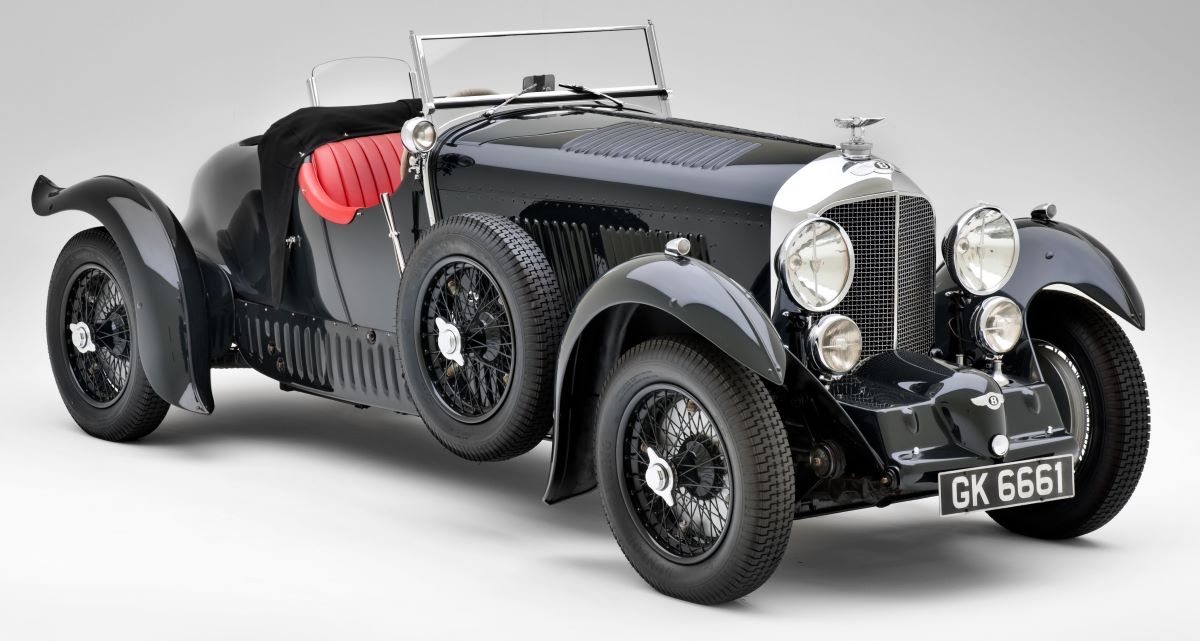
One-of-a-kind 1930 4 ½-litre ‘Blower’ Bentley fitted with elegant Gurney Nutting coachwork
Born in 1895, Joel Woolf Barnato was a British financier and racing driver and one of the famous ‘Bentley Boys’ who all favoured the cars of W.O. Bentley. Barnato acquired his first Bentley (a 3-litre) in 1925 and won numerous Brooklands races in the car and then, having been inspired by the 1924 Le Mans win of John Duff and Frank Clement, he went on, 12 months later, to acquire the business itself.
Sadly, with the arrival of the Great Depression in 1931, Bentley Motors Limited went into receivership only to be purchased the same year by Rolls-Royce. Having previously purchased a share in Rolls-Royce, Barnato was able to return to the Board of Bentley in 1934.
Passion and position enabled Barnato to pursue his love of the Bentley brand and he owned a number of very special examples over the years. Three such models will feature in this year’s Salon Privé Bentley Masters at Blenheim Palace on Saturday 7th September. With more than 50 of the greatest Bentleys ever built displayed on Blenheim’s lawns, it will be a unique, one-off spectacular showcase, with Barnato’s cars sure to shine.
1930 Bentley 4 ½-litre; one of the legendary ‘Blower’ Bentleys. Now part of a private American collection, the ‘Blower’ came about following the urging of fellow ‘Bentley Boy’ Sir Henry “Tim” Birkin. Captain Woolf Barnato, then Chairman of Bentley Motors Limited, enlisted the support of noted engineer Amherst Villiers to design a supercharger for the 4 ½-litre 4-cylinder, 16 valve, overhead camshaft, Bentley engine. The Villiers Roots-Type Supercharger created approximately l0lbs of boost at 4000rpm, resulting in a top speed in excess of 105mph. In all, approximately 55 ‘Blowers’ were produced for the purpose of homologation with perhaps only 40 examples still in existence today. This beautiful one-of-a-kind race car, fitted with its elegant Gurney Nutting coachwork, was delivered to Captain Woolf Barnato in July 1930.
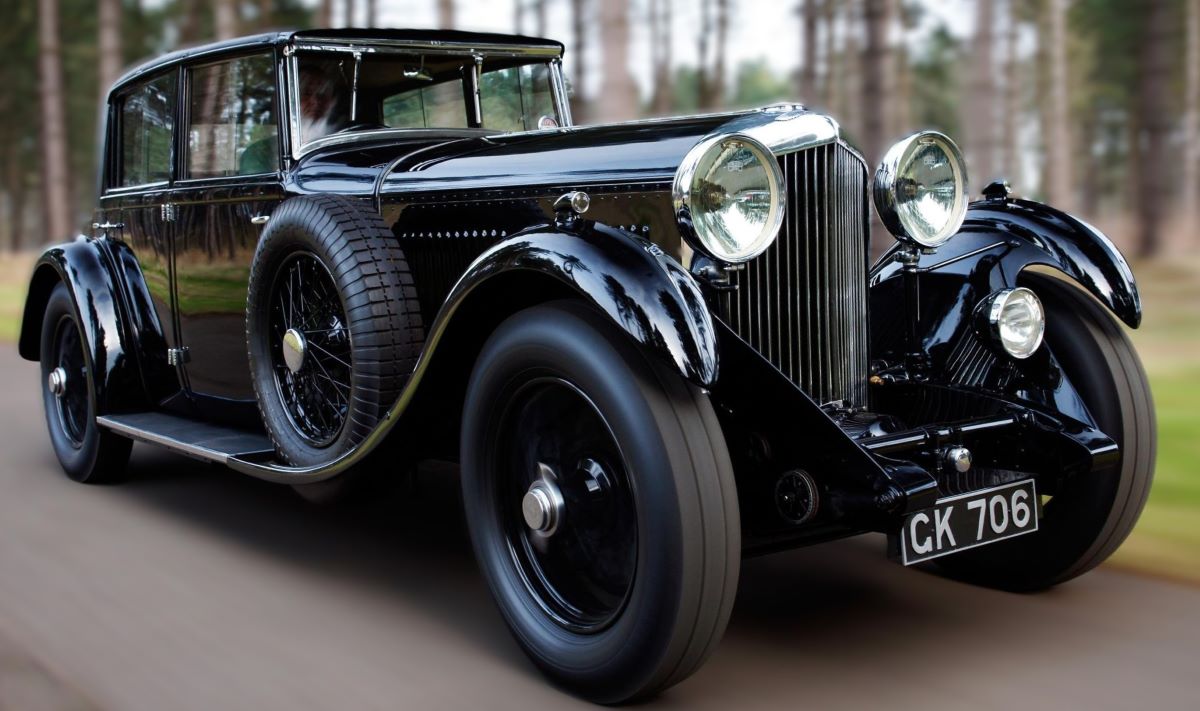
1931 8 Litre Park Ward Sports Saloon. Regarded as one of the finest models to have been created by the company’s founder W.O. Bentley, the 8-litre combined breath-taking performance for a grand saloon (it was capable of 100mph in 1930) with the height of bespoke luxury and comfort. A press review of the time simply described the 8 Litre as “motoring in its very highest form.”
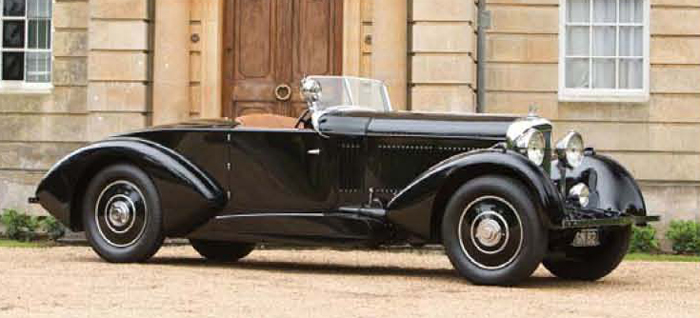
1931 Bentley 8-Litre Sports Coupe Cabriolet by Barker
The gentleman sportsman reviewing the selection of fine automobiles available to him in 1930 would certainly have been tempted by the 8-Litre Bentley. For the man who had everything, it was the automobile that had everything. Presence: It was over 20 feet long and as tall as a man, with an engine compartment more reminiscent of a locomotive than a car. Style: It was ideally proportioned for beautiful custom coachwork. Engineering: The exhaust pipe was asbestos-lagged, encased in aluminum to reduce resonance, and then coupled to a silencer the size of a 20-gallon waste bin. The starter engaged with surgical precision. Performance: Even with the heaviest custom coachwork, the 8-Litre was incredibly brisk and capable of 100 mph.
In every sense, the 8-Litre was probably the greatest British automobile ever produced. Yet, only 100 chassis were built before the sheer cost of developing and building such a machine drove the company into receivership. Other Bentleys would come in the decades to come, but the 8-Litre was the last of the “W.O.s,” the great driver’s cars built under Mr. Bentley himself. The majority of 8-Litre chassis were fitted with heavy, closed bodies, which were, for obvious reasons, often tossed aside by later owners and replaced with more sporting open coachwork. To find an 8-Litre with an open body that is the original for that chassis is extraordinarily rare, and most of those that do exist are four-passenger styles. Only a single 8-Litre was outfitted with two-passenger roadster bodywork when new.
Chassis number YR 5099 was the forty-ninth 8-Litre Bentley built, and it was one of thirty-four 12-foot wheelbase chassis intended for more sporting bodywork. That car had been bodied by Barker & Company, the London coachbuilders to the British Royal Family and numerous Indian princes, which was renowned for the fine quality of their work on a variety of chassis. Barker’s design for the Stewart Speed Six was a dashing two-passenger roadster with flowing individual fenders, curved pontoon-style running boards, and a tail that tapered into a gently rounded point, reminiscent of a boat’s stern. In American parlance, it would have been called a “boattail” speedster. Barker dubbed it a sports coupe cabriolet.
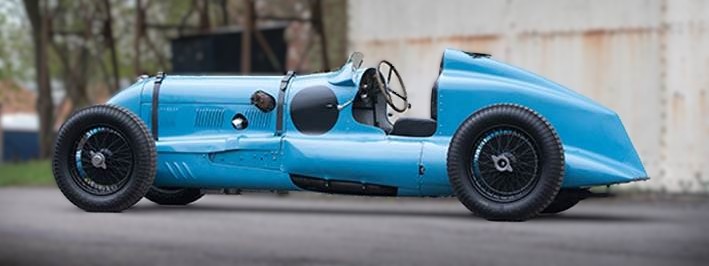
The sensational 1934 Barnato Hassan Special – the car that broke the Brooklands lap record with an average speed of 142.60 mph
The 1934 Barnato Hassan Special. This sensational single seater was commissioned by Captain Woolf Barnato a special project for one purpose only – racing. Powered initially by a 6 ½-litre Bentley engine with two S.U. carburetors, on a short (11 foot) chassis, the car was long, narrow and very fast. In 1935, the car was fitted with a newly designed body and a new 6 cylinder 8-litre Bentley engine with 3 S.U. carburetors, the combination of which enabled driver, Oliver Bertram, to break the Brooklands lap speed record with an average speed of 142.60 mph. Incredibly, this was achieved with an automotive engine under the bonnet – it took an aero-engined car, the Napier Railton, to beat it.
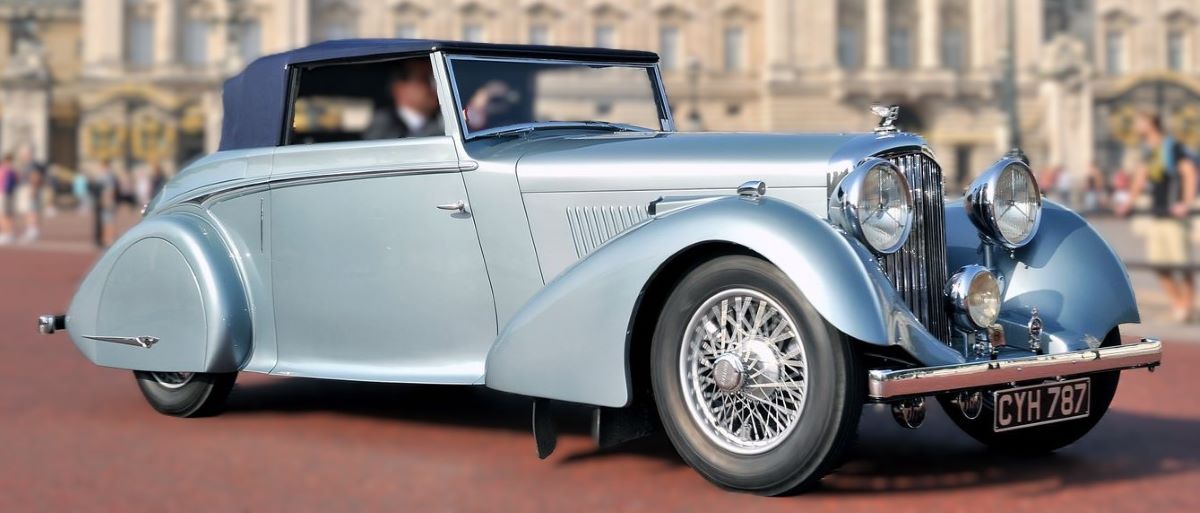
1936 4 ¼-litre by H. J. Mulliner featuring unique streamlined body and concealed hood
The 1936 4 ¼-litre drophead coupe. This model, with coachwork by H. J. Mulliner, was delivered to Barnato’s Mayfair home on 6th July 1936. The unique streamlined body with concealed hood, body no. 4226 was transferred from B2DG, a 3 ½-litre car, which was registered to Mrs. Woolf Barnato on March 15th 1935. Prior to this transaction the body was repainted in silver blue and the interior retrimmed in dark blue leather. A chromed dashboard with white faced dials was also fitted. It is an all matching numbers car that whilst having been restored, has remained as original as possible.
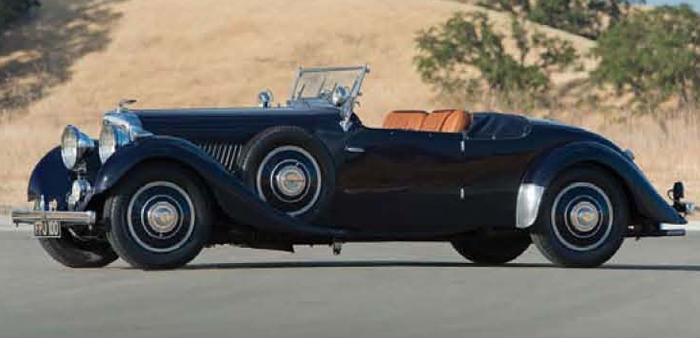
126 bhp, 4,257 cc OHV inline six-cylinder engine with two SU carburetors, four-speed manual gearbox with synchromesh on the third and fourth gears, front and rear semi-elliptic spring suspension with hydraulic shock dampers, and four-wheel mechanical brakes with servo-assist. Wheelbase: 126 in.
Rolls-Royce acquired Bentley Motors from Walter Owen Bentley in 1931 and then struggled for two years to design and build an appropriate car, one that would honor the “W. O. Bentley” sporting and racing heritage, yet one that would also not be confused with the more stately cars wearing the Rolls-Royce badge. The timing couldn’t have been any worse, as this was during the Great Depression. Rolls-Royce and Bentley Motors Works’ manager at Derby, E. W. Hives, CH MBE (developer of the Merlin aero engine and later the chairman of Rolls-Royce Ltd.), headed the team that was tasked with designing the all-new Bentley, which was set out to be a sports car that would appeal to a wide range of prospective buyers.
His personal notes read, “Answer to the moods of the driver…be driven fast with safety…tour without fuss and noise…maximum speed should not be obtained at the expense of acceleration…controls, steering, and brakes shall be light to operate, and the braking shall be adequate for a fast car…maximum speed of the car on the road should be 90 mph, 75 mph in third gear.”
The first “Rolls-Bentley,” a 3½-Litre model, was based on the current-series Rolls-Royce 20/25-horsepower chassis, but it was reconfigured to use the 20/25’s 2¾-liter engine. In 1936, the engine output was increased to 4¼ liters by using the Rolls-Royce 25/30-horsepower engine and chassis, but it came with a higher compression ratio (6.8:1 compared to 6:1) and the Rolls-Royce Stromberg downdraft single carburetor was substituted by dual SUs. The result was a fast, silky, exciting car that soon became known as the “Silent Sports Car.”
The Bentley cars that were produced in tandem with the Rolls-Royce cars of the 1930s have been, until recently, overlooked by collectors. This was due in part because they lacked the bulk and presence of the large-horsepower Rolls-Royce Phantom models, and also because so many Derby Bentley cars remained with their original owners in daily service for decades and weren’t offered for sale. They were often referred to as “Derbys,” as they were built in the shared Rolls-Royce and Bentley Motors Works in Derbyshire, England.
As was the custom in the 1930s, the new owner of the rolling Bentley chassis would have it sent to one of the bespoke coachbuilders, and they would build it to his specifications. Of the dozens of Bentley coachbuilders, Park Ward, Thrupp & Maberly, Vanden Plas, H.J. Mulliner, and Gurney Nutting were most often selected. Of the 1,234 Bentley 4¼-Litre chassis produced, over 530 were bodied by Park Ward, and most of them were steel saloons.
Carlton, a more exclusive body builder, bodied only a few Derby Bentley cars. The company was originally known as the E.B. Hall & Company, a North London horse-drawn carriage maker, but it evolved into designing and building very special car bodies on a few select Daimler, Rolls-Royce, and Bentley chassis. After they were licensed to produce the revolutionary Weymann fabric bodies, they changed the company name to Carlton Carriage Company. Of the four Carlton bodies fitted to 4¼-Litre chassis, the car offered here, chassis number B55KU, is the only two-seater open tourer ever built. The others were a sedanca coupe, a saloon, and a four-seater drophead coupe.
Carlton achieved quite an accomplishment with this exceedingly rare two-seat model, as he created a drophead that was just as attractive with the hood up as it was when lowered to its concealed-hood position. By positioning the touring spare in the front wing rather than the boot lid, the resulting profile became streamlined and elegant. The combination of Ace deluxe wheel discs (also known as “Easi-Clean”), a vintage Bentley-type fold-down twin aeroscreen (often called the Brooklands windscreen), a correct slanted Winged B mascot (which must be turned 90 degrees before the bonnet can be opened without chipping the paint), and its original Marschal headlamps and centrally mounted driving lamp result in a seriously appealing body style. Under the bonnet, the correctly restored and impeccable engine compartment properly stores the correct road tools. These are often missing, but they are preserved with this car and tidily fit in a tray under the boot floor’s carpeting. The period-correct color scheme of its midnight blue exterior and saddle tan interior is a perfect pairing.
No detail has been overlooked within the interior, as it was clearly designed for the owner who loves to take the wheel. Among the special-order instruments included with this car, as validated by the accompanying Works chassis card orders, is an extremely rare Smiths tachometer with a clock built into its center top. The instrument layout is equally atypical, with the speedometer and tachometer to the left of the driver’s position, and the ignition and lamp switches have been placed even farther to the left, in front of the single-passenger seat. As the car is a one-off design, it is presumed that this may be one of the first uses for this dash layout before it became standard on later cars.

You must be logged in to post a comment.